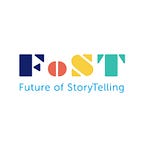Q&A with Immersive Storyteller Lizzie Stark
Part of the Future of StoryTelling Community Spotlight Series
Lizzie Stark is a participation designer, author, and LARP expert who is consistently pushing the boundaries of what it means to participate in theater. Her work has appeared at the FoST Summit and Festival, E3, the Stockholm Fringe Festival, the Kennedy Center’s ArtsEdge, IndieCade, and beyond. Her most recent work, The Night Café, is an interactive theater pop-up that will premiere in Boston on July 19 & 20.
How long have you been involved in immersive storytelling? What about immersive mediums inspire you or attract you to them?
I’ve been working with participatory storytelling for about a decade now. I’m passionate about making art; I think humans need to make it almost as much as they need food or water. I feel lucky that I get to spend my days creating it. That’s why I love participatory storytelling. For me, it means creating an environment that lets regular folks unleash their astonishing creativity.
How does a LARP differ from an immersive theater production or a traditional theater production?
I think this question could launch a number of PhD theses! Briefly, though, for me, the differences center on who has narrative control, who has agency, and how much.
In traditional theater, the audience doesn’t have much agency — they sit in the dark and experience the story the playwright wants to tell. At the other end of the spectrum, you’ve got larp, where the larp designer basically enters into a structured, collaborative process with participants, who steer their own stories and experience their own character arcs. As a designer, you have to do this very carefully because participants have their own ideas about where their stories should go and what they want their characters to do.
In the middle of the spectrum, you’ve got interactive and immersive theater, which covers a lot of territory, from work that doesn’t break the fourth wall so much as disperse it across a larger space and lets a mostly passive audience vote with their feet, to stuff that has participants solving puzzles and taking on a role in the production’s fiction.
Can you talk a bit about your upcoming experience? How can folks learn more or attend?
I’d love to. It’s a new interactive pop-up called The Night Cafe, set in the metaphysical beat cafe where insomniacs meet. I built it with my wonderful collaborator, Kellian Adams Pletcher of Green Door Labs. It’s half playful cafe, half small-group adventures featuring the works of other up-and-coming designers. Visitors can come explore what lies in the world between waking and dreaming, dig the band, and make the scene. It runs July 19 and 20 in the Boston area. You can read more and score tickets at www.visitthenightcafe.com.
Your experience “To the Bitter End” puts strangers in the center of an intimate relationship. What are some of your tried-and-true methods for creating openness and intimacy for those participating in your work?
I love all these big questions. As my collaborator on To the Bitter End Bjarke Pedersen always puts it, “you have to feel safe to be brave.” We pulled a lot of techniques out of our arsenal and baked them into every layer of design, but the big three are probably alibi, workshop, and trust.
We tried to provide participants with a strong alibi for behaving differently — we took responsibility for pairing them up; they didn’t play as themselves but as characters we had written; and our action cards provided them with instructions on how to sit, speak to, and even look at their co-participant.
In terms of workshop, essentially, it’s a way of training the participants so they feel confident and comfortable in the structures we’ve built for them to play in. We carefully construct activities to warm them up, teach them about the experience, and let them practice all needed skills. By the end of that, they are experts in the experience, and they aren’t sitting across the table from a stranger.
Lastly, we trust the participants with the experience. We trust them to read the description and opt in; we trust them to leave if they need to and we tell them how; and we also trust them with creating interesting play for one another.
In your opinion, what is the future of storytelling?
The future of storytelling is diversity. More people telling stories in more formats.
I think interactive storytelling — both digital and analog — is part of that future, since, as Kellian reminds me, we’ve raised a generation on super-customized content and set the expectation that they will be able to link, retweet, like, and comment on it. I think analog interaction design will continue to evolve, because we spend so much of our lives walled in by the glass of screens. Humans need to see other humans in a rich, detailed, high-resolution world, like the one we live in.
Interested in joining the conversation about the reinvention of stories in the digital age? Join our newsletter and apply now to attend the annual invitation-only Future of StoryTelling Summit at fost.org/apply.
